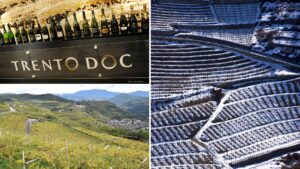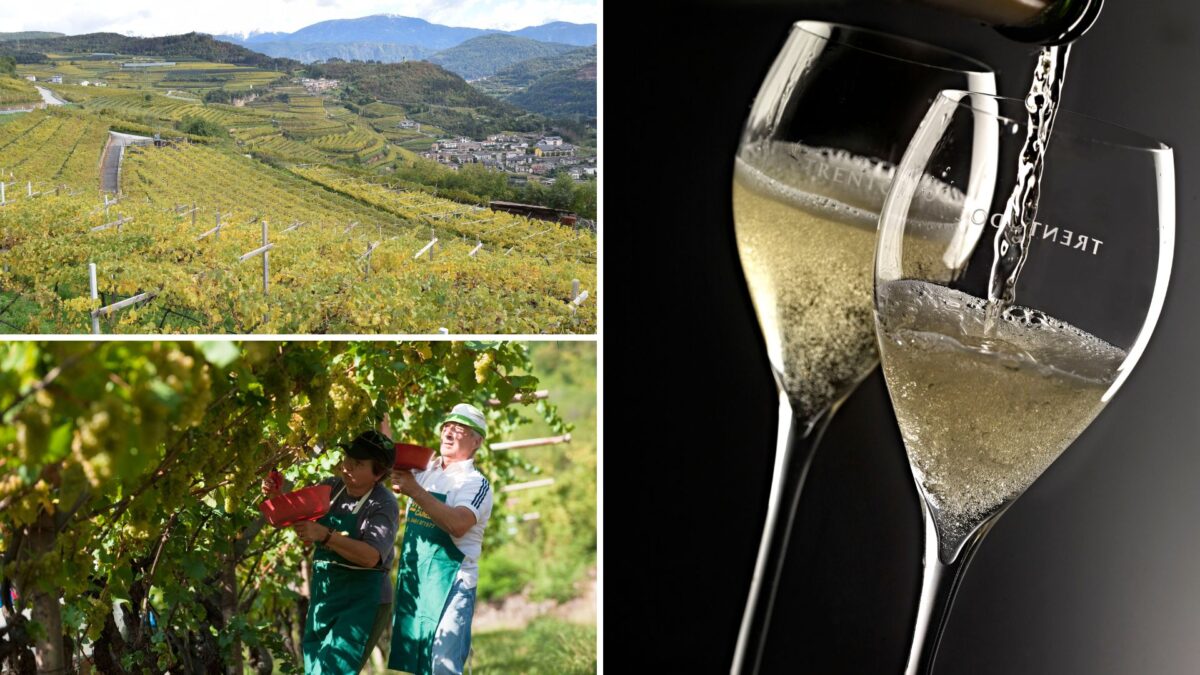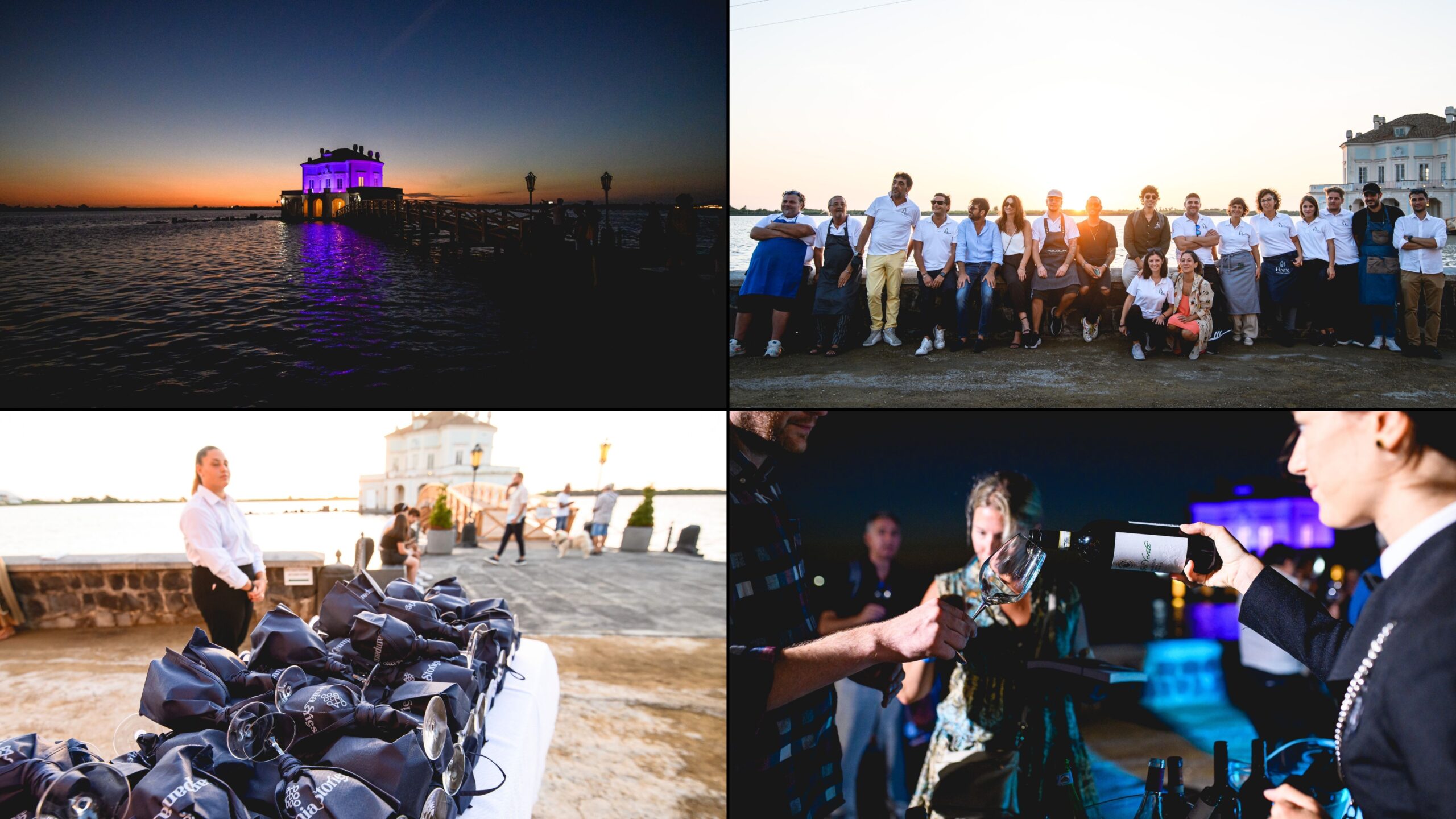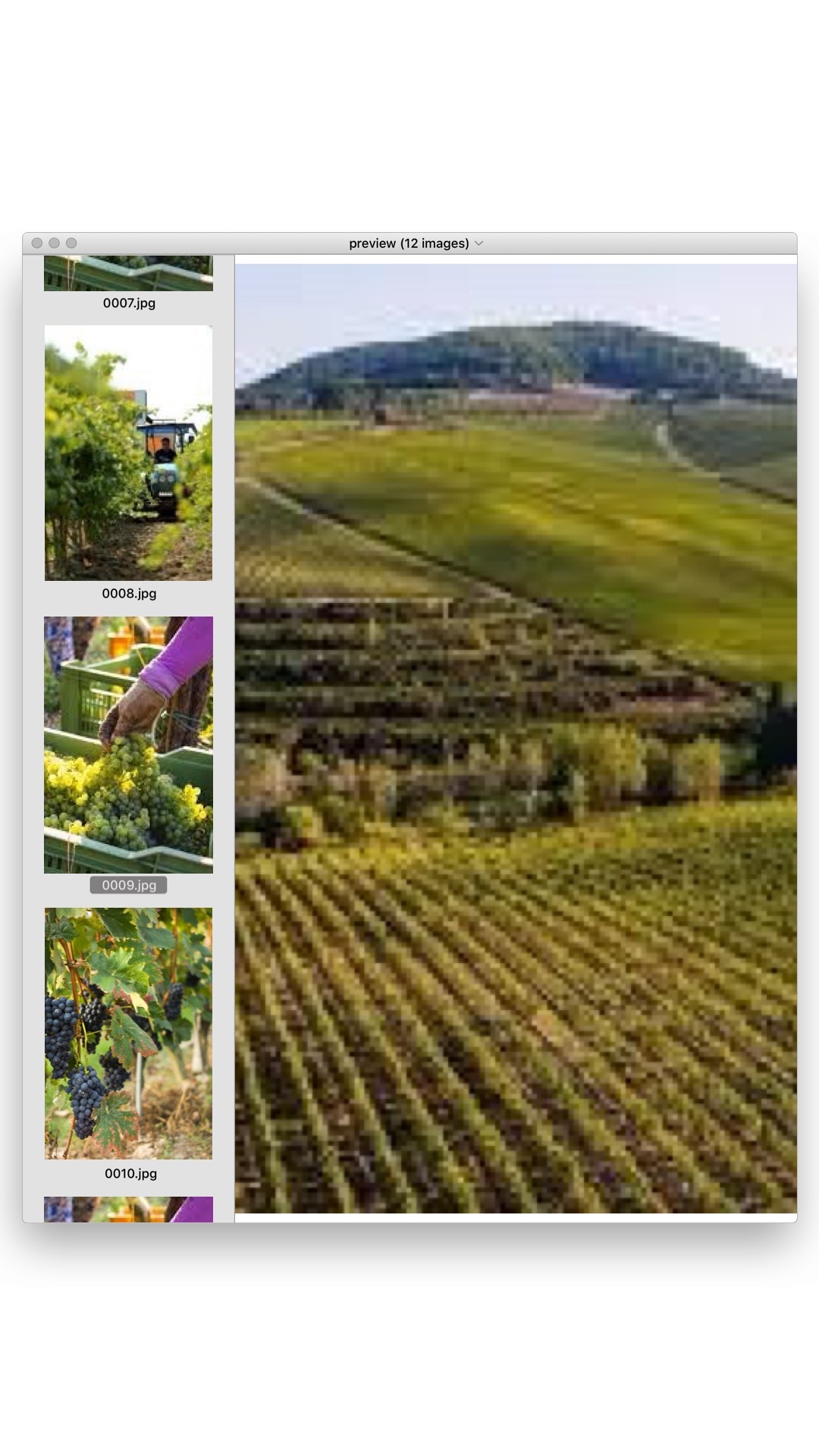Italy is renowned for its incredible wines, and one region that genuinely stands out is Trento. Located in the picturesque Trentino-Alto Adige region, Trento was voted “Wine Region of the Year in 2020” but it remains a hidden gem for many sparkling wine enthusiasts. Trento D.O.C wines have a long and storied history that dates back centuries. The region’s viticulture roots can be traced all the way back to the Roman Empire. However, it was during the Austrian rule in the 19th century that the art of winemaking in Trento developed a reputation for exquisite sparkling wines.
In the early 1900’s a young enologist named Giulio Ferrari recognized the geographic and climatic similarities between the Champagne and Trentino. He and other producers planted Chardonnay and began to make wines in the classic method. Pinot Noir and Pinot Meunier were soon planted as well, and these grapes quickly began to thrive. By 1993 the region received its D.O.C status becoming Italy’s first for sparkling wine in the classic method and one of the earliest traditional sparkling D.O.C’s in the world! In 2007 the collective trademark Trentodoc was created which now includes 67 producers affiliated with the Istituto Trento DOC.
Trentodoc is also an active partner with the Institute of Masters of Wine showing that the Trentodoc brand has achieved international recognition and upholds the excellence of classic method sparkling wines. The IMW’s support ensures the knowledge of the Trentodoc territory will be shared with their students and the global wine community.
The Terroir – A Perfect Blend of Nature’s Gifts
Trento’s unique terroir, with its breathtaking Alpine landscapes, plays a crucial role in the production of these extraordinary wines. The vineyards, nestled between the Dolomite Mountains and Lake Garda, benefit from a mild and temperate climate. The cool nights and warm days, combined with the well-drained soils, create the perfect conditions for grape cultivation. The mineral-rich soils derive their complexity from both oceanic and volcanic activity over millions of years. The high elevations of the vineyards maintain high acidity in the grapes. It’s interesting to note that 70% of the region’s vineyards are over 3200 feet and 20% over 6500 feet. The region gets plenty of sunshine and the warming effects of Lake Garda which helps ensure grape maturity. These significant temperature variations contribute to the complexity and elegance of Trento D.O.C wines. Trentodoc is produced in 6 areas: Rovereto and the Vallagarina, Valle dei Laghi and Alto Garda area, Trento and the Valle dell’Adige, the Valsugana, the Val di Cembra and the Piana Rotaliana.
The Classic Method
This meticulous process of the classic method “metodo classico” involves a second fermentation in each bottle, resulting in fine bubbles and complex flavors. A base wine is first made following the same steps as a still wine. The wine is then bottled and a ‘liqueur de tirage’ is added which is made of yeast and sugars. This eventually triggers a second fermentation in the bottle releasing carbon dioxide creating bubbles. The bottles are placed on racks angled downwards so that the dead yeasts slowly collect in the neck of the bottle. This is called ‘riddling’. The sediment is eventually removed, a process called ‘disgorgement’ and reserve wine with sugar can be added according to the ‘dosage’ which ultimately determines the sweetness of the wine. Trento D.O.C sparkling wines require at least 15 months of aging on the lees adding depth and richness to the wines. Vintage wines require 24 months of lees aging and Riserva wines require 36 months. The DOC requirements are also applied to vine cultivation and yield.
The Grapes – the Essence of Elegance
The primary grape varieties used in Trento D.O.C wines are Chardonnay, Pinot Noir, and Pinot Meunier. These grapes imbue the wines with remarkable elegance, character, and freshness. Each variety adds its own unique personality to the final blend, ensuring a diverse range of flavors. Chardonnay brings acidity and a delicate floral aroma, while Pinot Noir contributes structure and fruity notes. Pinot Meunier adds complexity and brings out a rich aromatic profile in the wines. Due to the steep mountainsides in the Trentino region, many of the vines are trained using the pergola system. Vines are trained vertically straight up posts and then tied horizontally parallel to each other. This method ensures they get enough sunshine but also makes it easier to prune them. Harvesting is still done by hand. Other vine training methods are also used here such as guyot and spurred cordon.
A Symphony of Flavors
Trento D.O.C sparkling wines offer a delightful sensory experience. With their pale straw color and fine perlage, they captivate the eye. On the nose, aromas of white flowers, green apple, and citrus fruits come alive, inviting you to take your first sip. The palate reveals a perfect balance of crisp acidity, creamy mousse, and a medley of flavors, including toasted almonds, brioche, and ripe tropical fruits. The overall effect is both elegant and refreshing, leaving a lasting impression.
Pairing Trento D.O.C wines with the right food elevates the whole tasting experience. The refreshing acidity and complex flavors of these sparkling wines make them a perfect companion for many dishes. From seafood and sushi to creamy risottos and aged cheeses, their versatility makes them an ideal choice for any occasion. The fine bubbles and vibrant acidity also help cleanse the palate and enhance the flavors of the food.

Exploring A Wine Lover’s Paradise
For wine enthusiasts seeking a unique and memorable experience, a visit to Trentino will not disappoint. A short drive north of Lake Garda and you are surrounded by forest-covered hills and the dramatic peaks of the Dolomites. Trento itself is one of the liveliest towns in the Alps. Colorful facades surround charming piazzas and the castle and cable cars offer breathtaking views of the surrounding mountains. Many wineries are just outside of town. Winery visits can be combined with a trip to the lake or a hike into the nearby canyons. Most wineries offer tours and tastings that allow you to discover not only the intricacies of the region’s winemaking process but also to explore the vineyards with spectacular landscapes.
For active travelers, visiting Trentino is a sports lover’s dream. The Dolomites offer world-class biking, hiking, and trekking through breathtaking landscapes. Lake Garda offers ideal conditions for windsurfing and other water sports. If you choose to visit in the winter you can ski or snowboard out of your chalet and in less than a half hour be sipping bubbles at a local winery. Additionally, every year in November and December Trento puts on its ‘Bubbles in the City’ event which offers different types of tastings and food workshops with local chefs.
Wineries to Visit
Altemasi
Produced by Cavit one of the leading wine groups in Trentino. The name Altemasi means “high estate” and these wines come from vineyards as high as 2600 feet and are some of their most awarded wines. Cavit’s wine enoteca just outside Trento is a great place to taste an impressive array of wines from the region, both still and sparkling.
www.altemasi.it
Abate Nero
Founded in 1973 by two friends, Eugenio de Castel Terlago and winemaker Luciano Lunelli. The name means “black abbot” and is a reference to the dark robe the monk Dom Perignon wore. They started in the same cellars where Giulio Ferrari wines were once made, focusing only on sparkling wines in the classic method. They have earned a reputation for producing wines that are a stylistic symbol of the Trentino territory.
www.abatenero.it
Balter
Located in a 16th-century castle bought by Francesco Balter in 1872, the Balter family has used this special location to grow grapes since the 1960’s. They built a winery underneath the vineyards in 1990. Visitors can tour the grounds and taste their wines in a truly unique setting.
www.balter.it
Cantina Toblino
Located in the Valle dei Laghi area just north of Lake Garda this winery is a cooperative founded in 1960 by a group of passionate winemakers. The winery produces some of the region’s top wines using innovative techniques and promoting native varieties such as Nosiola, also used to make the sweet Trentino Vino Santo. Visitors can enjoy lunch or dinner at their restaurant Hosteria Toblino which serves traditional dishes with a modern touch.
www.toblino.it
Cesarini Sforza
The Cesarini Sforza Family moved to Trento 200 years ago when Count Filippo Cesarini Sforza was elected as its mayor. In 1974 they created a winery to produce high-quality sparkling wines. Two years later they were making classic method wines of national repute. Today their wines are an assemblage of six different vineyards each contributing their own character.
www.cesarinisforza.it
Ferrari Trento
Founded in 1902 by Giulo Ferrari, a pioneer in Trentino who recognized the potential of Chardonnay to produce sparkling wines that could rival those in Champagne. His vision and obsession for quality laid the foundation for one of Italy’s most prominent classic method wineries. With no sons or daughters, Giulio passed on leadership to a local wine shop owner, Bruno Lunelli in 1952. The Lunelli Family had carried on their tradition of excellence since then. Visitors can enjoy several different tastings and guided tours including that of the Venetian style 16th century Villa Margon complete with frescoes, antique furniture and priceless art. For those who enjoy Michelin-star dining experiences, the Lunelli Family also opened Locanda Margon, a 2-star restaurant just up the hill from the winery.
www.ferraritrento.com
Monfort
Four generations of winemakers have carried on the sparkling wine tradition of Monfort. In 1965 the Simoni Family bought the cellars of Palazzo Monfort nestled in the heart of the town of Lavis just north of Trento. Since 1985 they have been producing quality sparkling wines in the classic method. They offer an immersive guided tour of the cellars that also takes you through the historic streets of Lavis to the terraced botanical garden of Ciucioi.
www.cantinemonfort.com
Marchesi Guerrieri Gonzaga
Originally a monastery in the early Middle Ages, the San Leonardo estate has been the residence of the Marquis Guerriere Gonzaga for over 300 hundred years. Today the family produces still, sparkling wines, grappa and honey. The Marchesi Guerrieri Gonzaga is a blanc de blanc Trento Doc flagship wine. The estate is comprised of 50 acres of vineyards, their guided visit explores the grounds, winery, cellars, monastic garden, church, and museum.
www.sanleonardo.it
Photos: Istituto Trento Doc








